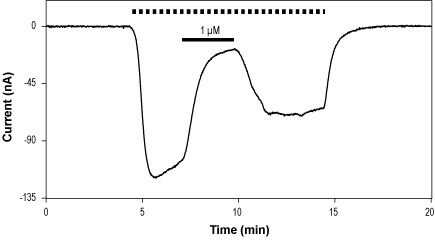Overview
- Uchida, I. et al. (1996) Eur. J. Pharmacol. 307, 89.
- Beato, M. et al. (2007) J. Physiol. 580, 171.
 Alomone Labs Gabazine inhibits GABA(A) receptors expressed in Xenopus oocytes.Time course of GABA(A) α1/β2 currents, activated by a continuous application (top dotted line) of 0.1 µM γ-Aminobutyric acid (#G-110), and inhibited by 1 µM Gabazine (#G-215), as indicated, while membrane potential was held at -60 mV.
Alomone Labs Gabazine inhibits GABA(A) receptors expressed in Xenopus oocytes.Time course of GABA(A) α1/β2 currents, activated by a continuous application (top dotted line) of 0.1 µM γ-Aminobutyric acid (#G-110), and inhibited by 1 µM Gabazine (#G-215), as indicated, while membrane potential was held at -60 mV.
- Uchida, I. et al. (1996) Eur. J. Pharmacol. 307, 89.
- Beato, M. et al. (2007) J. Physiol. 580, 171.
- Heaulme, M. et al. (1986) Brain Res. 384, 224.
- Pomara, N. et al. (2015) Prog. Neuropsychopharmacol. Biol. Psychiatry. 56, 35.
- Iqbal, F. et al. (2011) Bioorg. Med. Chem. Lett. 21, 4252.
Gabazine (SR-95531) is a specific, competitive and potent antagonist of GABA(A) receptors. The compound also blocks glycine receptors but with lower affinity. SR-95531 acts as an allosteric inhibitor of GABA(A) receptor channel opening1,2 and blocks GABA-evoked currents with an IC50 of 0.44 µM1. When SR 95531 was administered intravenously it was shown to cause seizures in mice3.
GABA(A) receptors are members of the Cys-loop superfamily of ligand-gated ion channels. They mediate the GABA action, a major inhibitory neurotransmitter, throughout the central nervous system (CNS) and play an important role in inhibiting cell excitation in the CNS. The GABA(A) receptor is considered to be a major target of anti-seizure drugs4,5.
Gabazine (#G-215) is a highly pure, synthetic, and biologically active compound.

